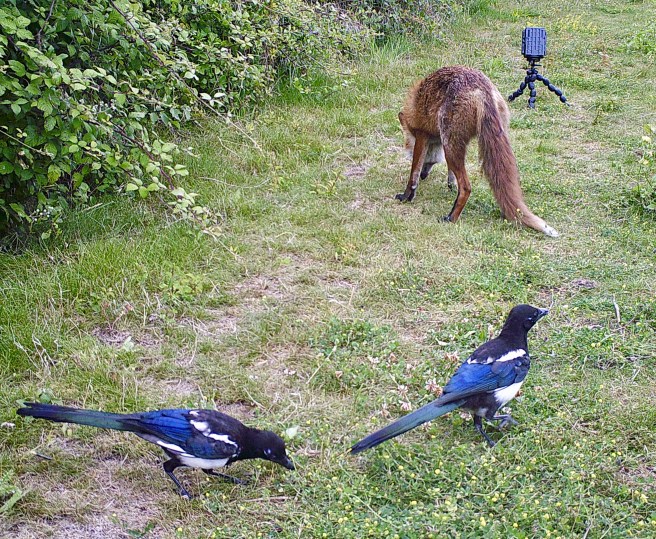There is an area in the far corner of the second meadow where Creeping Thistle grows enthusiastically.

Too enthusiastically – Creeping Thistle can become very invasive and actually is classified as an injurious weed under the Weeds Act 1959 and we have a duty to control it and prevent its spread. However, it also has great wildlife value – Thistle seeds make up a third of a Goldfinch’s diet, for example, as well as the leaves being the larval food plant for Painted Lady butterflies. Its nectar is loved by many invertebrates and its stems are important as a habitat for overwintering insects.

In order to control these Creeping Thistles, at this time of year we cut this area that has a high density of them. We aim for when they are flowering and just about to go to seed when maximum reserves from the roots are up above ground and so will be cut away and the seeds haven’t yet dispersed.

The densest area of Thistle growth is now removed, although there is no need to worry about the Goldfinches and the Painted Ladies – there is still plenty of Creeping Thistle in the meadow, just more sparsely spread out.
So, the 2019 cutting of the meadows has begun, although there will now be a pause in the proceedings until September.
Gatekeepers have arrived in the meadows with the double white spots within a black spot:


And Ruddy Darters. I usually struggle to tell the difference between a Ruddy Darter and a Common Darter because my photos aren’t good enough. But this time I can see that this is a Ruddy Darter with its all-black legs. The Commons have a white stripe down them.


There was also this Broad-bodied Chaser female up at the hide pond where there is more open water:

This Hoverfly below is a Hornet mimic and it is enormous. The wing length of the Hornet Hoverfly is 15.5 to 19.5mm:

Earlier this year I was taking photos of Dance Flies catching St Mark’s flies and charmingly offering the carcass as a present to a potential mate. Here is another predatory fly with Hoverfly prey:

I believe that this is the Downland Robberfly (Machimus rusticus), a rare fly found on chalk and limestone downlands.
Currently there are far fewer small birds coming to the seed that we are putting down on the strip and we haven’t seen the Grey Partridge and Yellowhammer for a while. Hopefully the reason for this is that seeds are becoming abundant elsewhere in the meadows at this time of year. We are still getting a lot of Stock Dove, though:

And Foxes and Magpies unfortunately. They love the sunflower heart element of the seed mix:





The bird ringer visited a nearby location where they are also putting down seed and they have breeding Turtle Dove and many other bird visitors. He noticed that many of the birds visited their pond first before coming to feed on the seed and suggested that we create a water source up near the strip. So this was this morning’s project:



We now have cameras on both of these cheap and cheerful tiny ponds and so we shall see what happens next.
The House Sparrows have gone straight on to rear another brood in the House Martin box. I read that they can have up to four broods in a good summer and are faithful to each other and their nest site. Once one set of youngsters fledge, the male continues to look after them out in the big wide world for about a week while the female gets straight on with preparations for the next lot.

The screaming parties of Swifts, attracted in by playing Swift calls, continue unabated and have become a very familiar part of the soundscape here. They also present us with the interesting photographic challenge of trying to capture a half decent image of them.

My trusty, lightweight camera (Olympus OM-D EM10) has been broken in a wine-related incident in France (I fumbled and dropped it after a glass of wine). This is the camera for which I have several lenses including the really useful macro lens and so I am going to buy a new body. But currently I am down to my much heavier DSLR – Canon 80D- with its 18-135mm zoom which is just not a long enough lens for me.
So I took the plunge and today this second-hand beast arrived:

I went out into the meadows with it and I am very excited with the results so far. The images below were all of things that were a very long way away!




As well as the House Sparrows going for another brood, it seems that the Woodpigeons are as well:




Here are some other photos from the meadows over the past few days:








Only a few photos from the wood this time. Every Ragwort now has Cinnabar Moth caterpillars on it:


This is not surprising given the number of Cinnabar Moths that were flying earlier on in the year:

I also saw a mating pair of Yellow-and-black Longhorn Beetles:



Now, hold on to your hats for this last bit. The bird ringer sent me some photos showing us what he has been up to this past week. These are not photos from the meadows or the wood but they are all from this part of East Kent and are extremely good and interesting and cannot be left out! They were all taken on his Samsung Galaxy 8 phone and I do have his permission to include them:









He also unsuccessfully tried to ring Nightjars one night, getting to bed at 1.30am. He certainly had quite a week.
